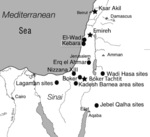MP-UP Transition in Kebara Cave (Israel): Chronology and Chemistry from 50,000 Years Ago
| Date/Time: | Friday, 31 Aug 2012 from 4:10 pm to 5:00 pm |
|---|---|
| Location: | Physics 3 |
| Contact: | Massimo Marengo |
| Phone: | 515-294-1080 |
| Channel: | College of Liberal Arts and Sciences |
| Actions: | Download iCal/vCal | Email Reminder |
The migration of anatomically and behaviorally modern humans (AMH) from Africa into Asia and Europe marks the beginning of the Upper Paleolithic. The descendants of these Homo sapiens sapiens eventually displaced the indigenous Neanderthal inhabitants and paved the way for the cultural evolution of modern humanity.
Kebara Cave, Israel, archaeological record cover the time of this transition, late Middle Paleolithic to the early Upper Palaeolithic. The location of this cave in the southern Levant implies that this is one of the first areas that anatomically and behaviorally modern humans reached when they left Africa. The new absolute radiocarbon dates on charcoal from Kebara Cave has improved our understanding of the chronology of this transition and also the interaction of the material used for dating and the environment.
